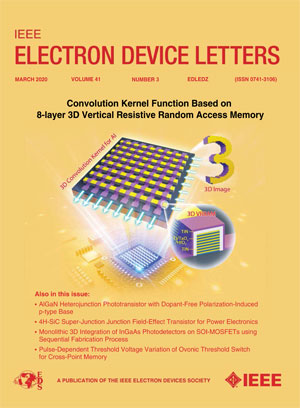Record Low Contact Resistivity of 10-8 Ω cm² Ohmic Contacts on Oxygen-Terminated Intrinsic Diamond by Transition Metals Metallization
IF 4.1
2区 工程技术
Q2 ENGINEERING, ELECTRICAL & ELECTRONIC
引用次数: 0
Abstract
For the first time, robust ohmic contacts were successfully prepared on oxygen-terminated intrinsic diamond with insulating surface and rare carrier concentration by transition metals (TMs, including Pt, Ru, W, Cr, Zr and V) metallization. The record low specific contact resistance of通过过渡金属金属化技术在氧淬火本征金刚石上实现 10-8 Ω cm² 欧姆触点的低接触电阻率记录
通过金属化过渡金属(TMs,包括铂、钌、钨、铬、锆和钒),首次在具有绝缘表面和稀有载流子浓度的氧封端本征金刚石上成功制备了稳健的欧姆触点。创纪录的低比接触电阻为 ${2}.{5}\times {10}.^{-{8}}~\Omega $ cm2,铂接触以金属状态扩散到金刚石中,没有产生碳化物,但产生了 sp2 碳和空位缺陷。我们发现,金刚石内金属化诱导的充满导电缺陷(如 TMs、TM 碳化物、sp2 碳和氮空位色心)的浅损伤层是欧姆接触形成的关键原因,它起到了连接电极接触和块体金刚石的导电分流作用。我们的研究结果扩展了在金刚石上形成可靠、高效欧姆接触的方法和理论。
本文章由计算机程序翻译,如有差异,请以英文原文为准。
求助全文
约1分钟内获得全文
求助全文
来源期刊

IEEE Electron Device Letters
工程技术-工程:电子与电气
CiteScore
8.20
自引率
10.20%
发文量
551
审稿时长
1.4 months
期刊介绍:
IEEE Electron Device Letters publishes original and significant contributions relating to the theory, modeling, design, performance and reliability of electron and ion integrated circuit devices and interconnects, involving insulators, metals, organic materials, micro-plasmas, semiconductors, quantum-effect structures, vacuum devices, and emerging materials with applications in bioelectronics, biomedical electronics, computation, communications, displays, microelectromechanics, imaging, micro-actuators, nanoelectronics, optoelectronics, photovoltaics, power ICs and micro-sensors.
 求助内容:
求助内容: 应助结果提醒方式:
应助结果提醒方式:


